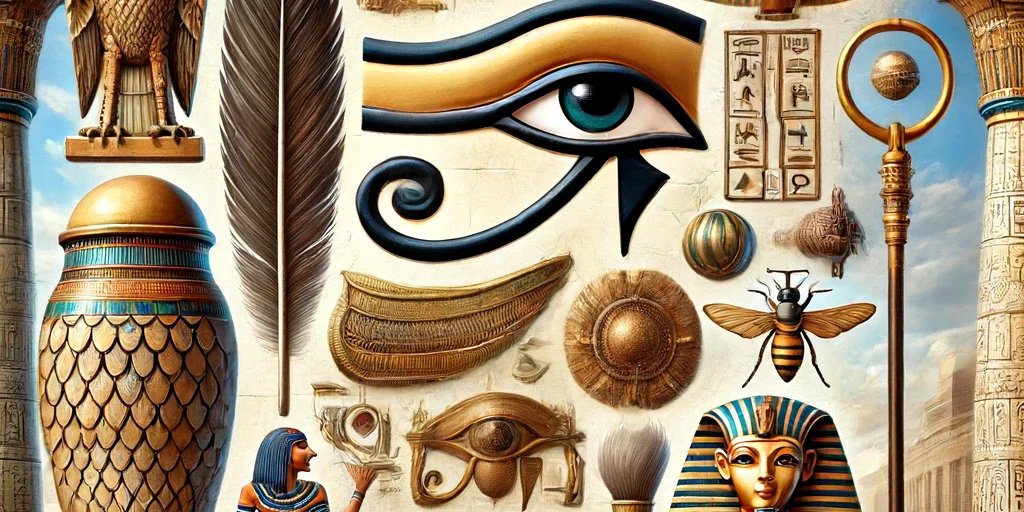Introduction
Ancient Egypt is known for its rich tapestry of symbols that have fascinated scholars, historians, and enthusiasts for centuries. These symbols were more than just artistic representations; they were integral to the Egyptians’ understanding of the world around them. From religious and mythological icons to daily life and funerary symbols, each had its own unique significance. In this article, we will explore 100 of the most famous ancient Egyptian symbols and delve into their meanings and the roles they played in ancient Egyptian culture.
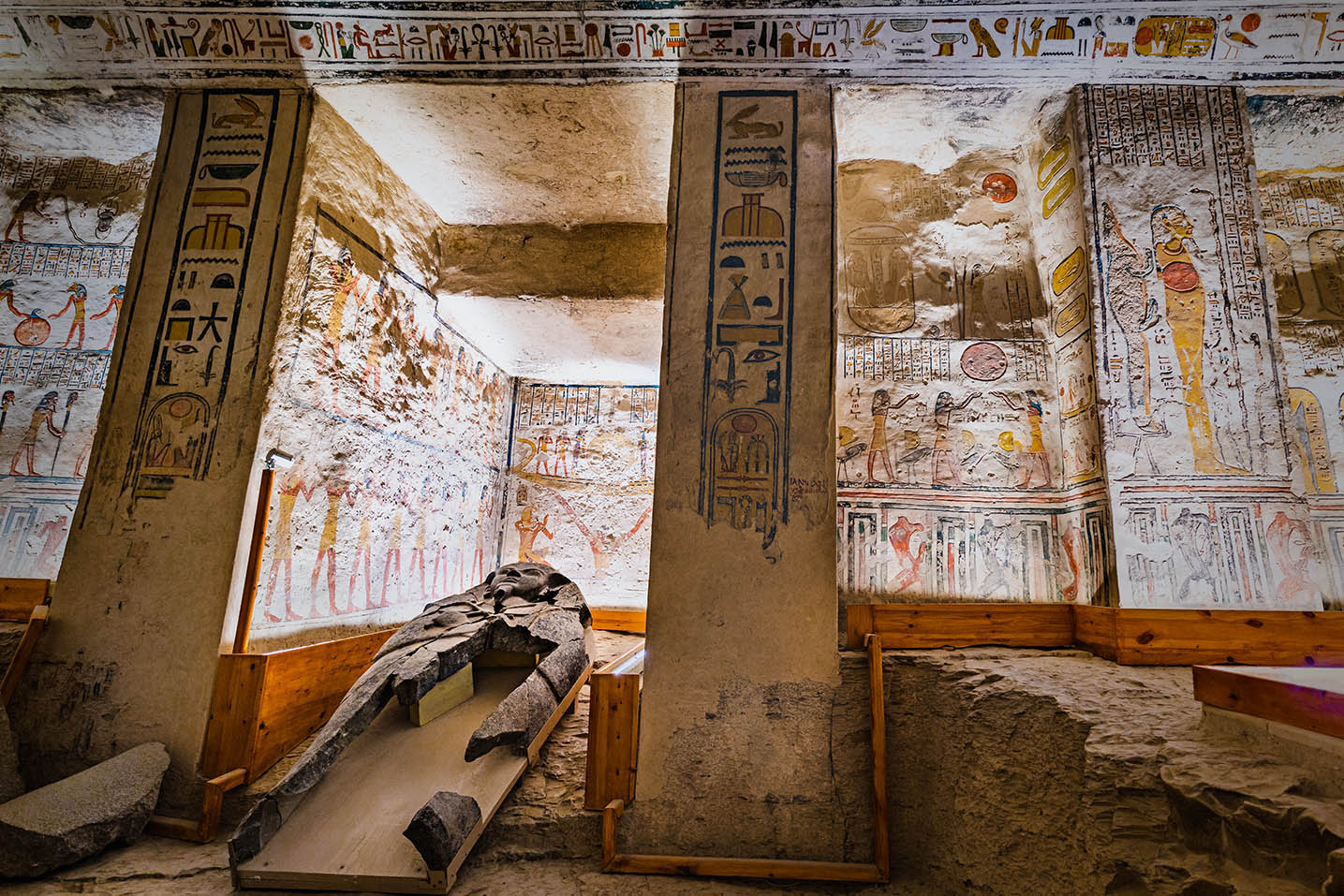
Religious and Mythological Symbols
1. Ankh (Symbol of Life):
The ankh is a well-known symbol that represents eternal life. Often depicted in the hands of gods and pharaohs, it was used in hieroglyphs to signify life and immortality.
2. Eye of Horus (Protection and Royal Power):
Also known as the “Udjat,” the Eye of Horus symbolizes protection, health, and royal power. It was commonly used in amulets to safeguard against evil.
3. Scarab (Rebirth and Transformation):
The scarab beetle, associated with the god Khepri, symbolizes rebirth and the eternal cycle of life. Scarab amulets were frequently placed in tombs to protect the deceased.
4. Djed (Stability):
Representing stability and strength, the Djed pillar is associated with Osiris, the god of the afterlife. It was often placed in tombs to ensure the stability of the deceased in the afterlife.
5. Was Scepter (Power and Dominion):
The Was scepter symbolizes power and authority. It was carried by gods and pharaohs as a sign of their control and dominion over the land.
6. Shen Ring (Eternity):
The Shen ring, symbolizing eternity and protection, was often seen encircling the names of pharaohs, signifying eternal power and protection.
Symbols of Deities
7. Amun (Ram):
Amun, a major deity, is often depicted as a ram or with a ram’s head, symbolizing fertility and creative power.
8. Bastet (Cat):
The goddess of home and fertility, Bastet is depicted as a lioness or a domestic cat, representing protection and nurturing.
9. Hathor (Cow):
Hathor, the goddess of love and motherhood, is shown with cow horns or as a cow, symbolizing nurturing and joy.
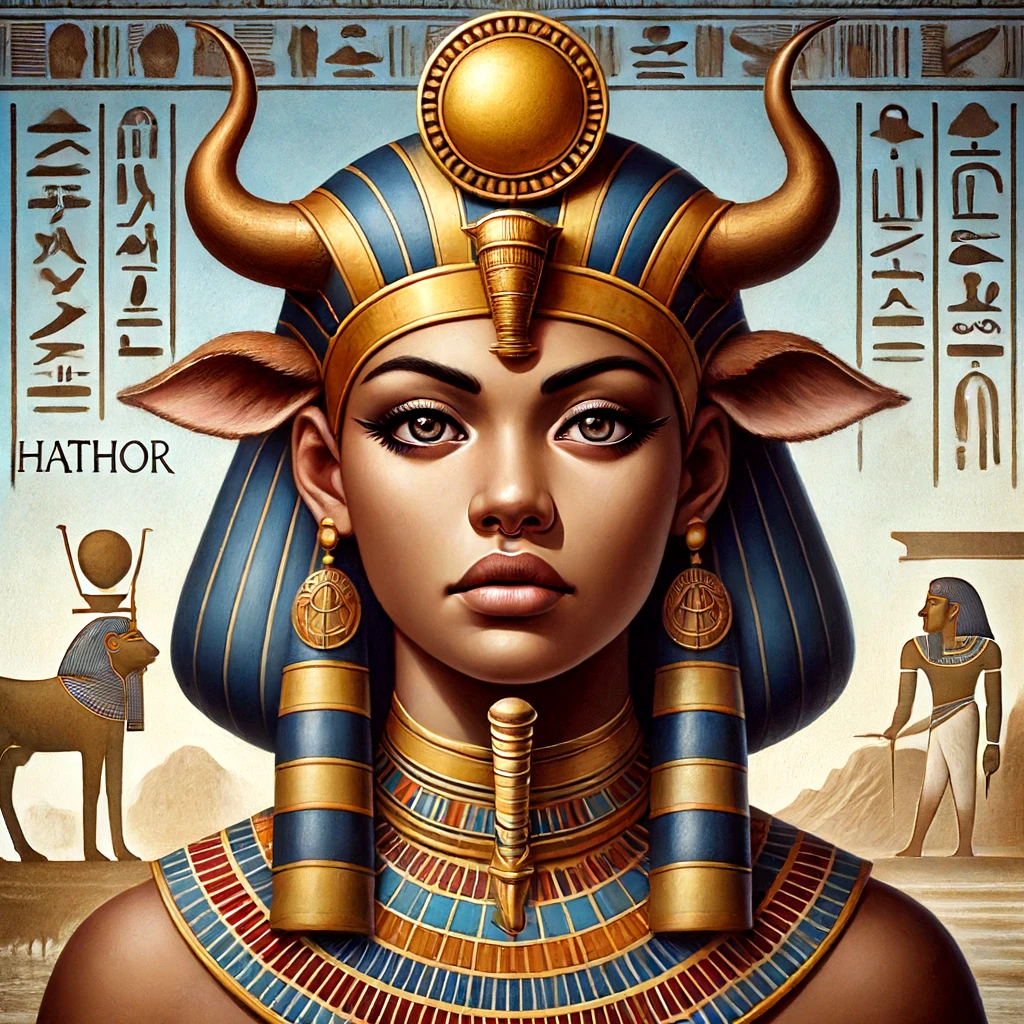
10. Osiris (Djed Pillar):
Osiris, the god of the afterlife, is associated with the Djed pillar, representing stability and resurrection.
11. Isis (Throne):
Isis, the goddess of magic and motherhood, is symbolized by a throne. She is often depicted with a throne-shaped crown.
12. Anubis (Jackal):
Anubis, the god of mummification and the afterlife, is depicted as a jackal. He is a protector of the dead and overseer of mummification.
13. Ra (Sun Disk):
Ra, the sun god, is represented by the sun disk, symbolizing the life-giving power of the sun. He is often shown with a sun disk above his head.
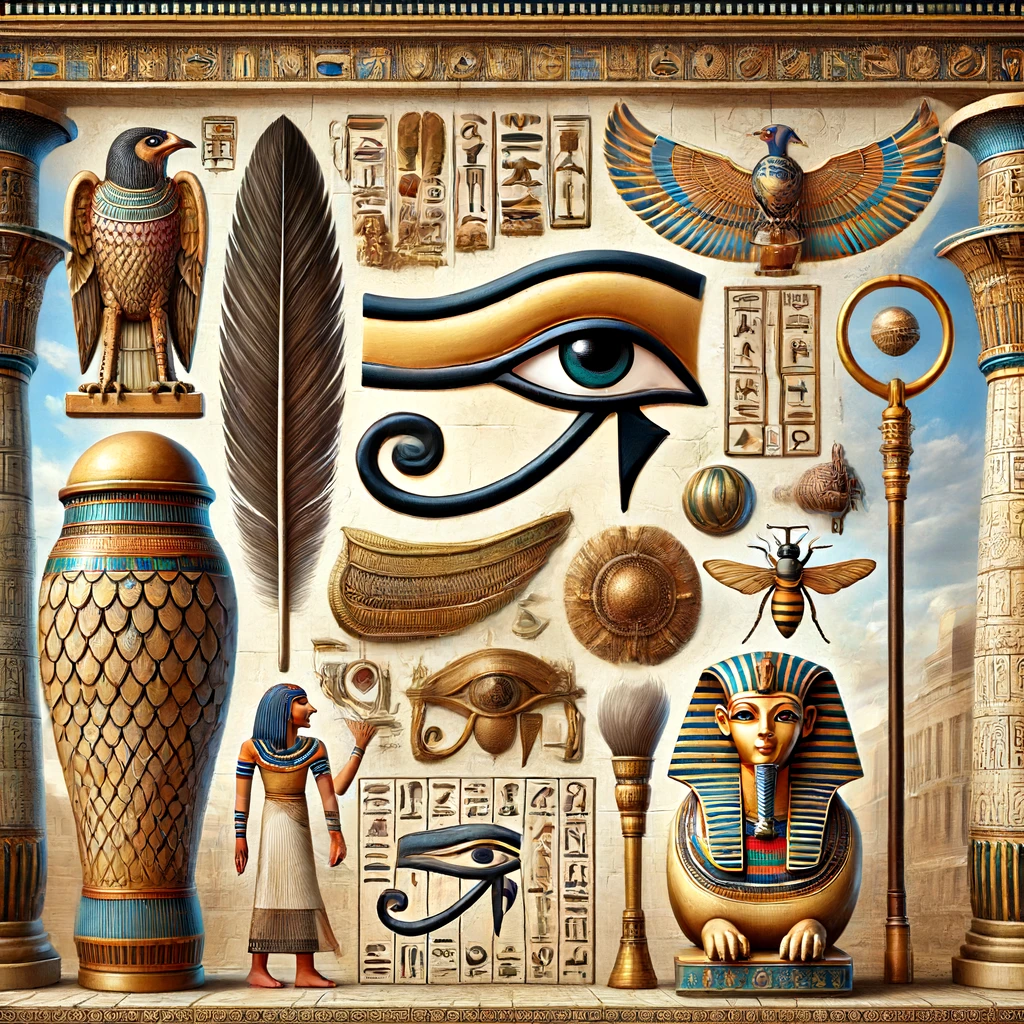
Funerary and Afterlife Symbols
14. Canopic Jars (Preservation of Organs):
Used to store the internal organs of the deceased, canopic jars were protected by the four sons of Horus. Each jar was dedicated to a specific organ and deity.
15. Feather of Ma’at (Truth and Justice):
The feather of Ma’at represents truth, justice, and balance. It was used in the weighing of the heart ceremony to judge the deceased’s soul.
16. Udjat (Eye of Horus):
The Udjat, or Eye of Horus, is a symbol of protection and healing, often used in tombs and rituals.
17. Cartouche (Royal Name Protection):
A cartouche is an oval with a horizontal line at one end, encircling a royal name, symbolizing protection for the pharaoh’s name and authority.
18. Sedge and Bee (Kingship of Upper and Lower Egypt):
The sedge plant and bee represent the pharaoh’s rule over Upper and Lower Egypt, symbolizing the unification of the two lands.
19. Crook and Flail (Pharaonic Authority):
The crook and flail are symbols of the pharaoh’s authority, representing leadership and discipline. They are often depicted crossed over the chest of the pharaoh.
20. Uraeus (Royal Serpent):
The Uraeus, a rearing cobra, symbolizes sovereignty and divine authority. It was often worn on the pharaoh’s crown to signify protection and power.
Natural and Cosmic Symbols
21. Lotus (Creation and Rebirth):
The lotus flower symbolizes creation and rebirth. It is often depicted in art and architecture, representing the cycle of life and the emergence of order from chaos.
22. Papyrus (Life and Fertility):
Papyrus represents life and fertility, reflecting the lush vegetation of the Nile Delta. It was a key resource for making paper, boats, and other items.
23. Sun Disk (Ra and Solar Deities):
The sun disk is a powerful symbol associated with Ra and other solar deities, representing the life-giving power of the sun.
24. Bennu Bird (Phoenix, Symbol of Rebirth):
The Bennu bird, similar to the phoenix, symbolizes rebirth and renewal. It was believed to play a role in the creation of the world and the resurrection of the dead.
25. Hieroglyph for Water (N):
The water ripple symbol represents the sound “n” and is commonly used in hieroglyphic writing, often appearing in texts related to the Nile and water.
26. Hieroglyph for Reed (A):
The reed symbol represents the sound “a” or “i” and is a common hieroglyph found in words related to plants and vegetation.
27. Hieroglyph for Owl (M):
The owl symbol represents the sound “m” and is frequently used in inscriptions, associated with wisdom and nocturnal knowledge.
28. Hieroglyph for House (P):
The house symbol represents the sound “p” or “ph” and is a key component in hieroglyphic text, often used in words related to buildings and architecture.
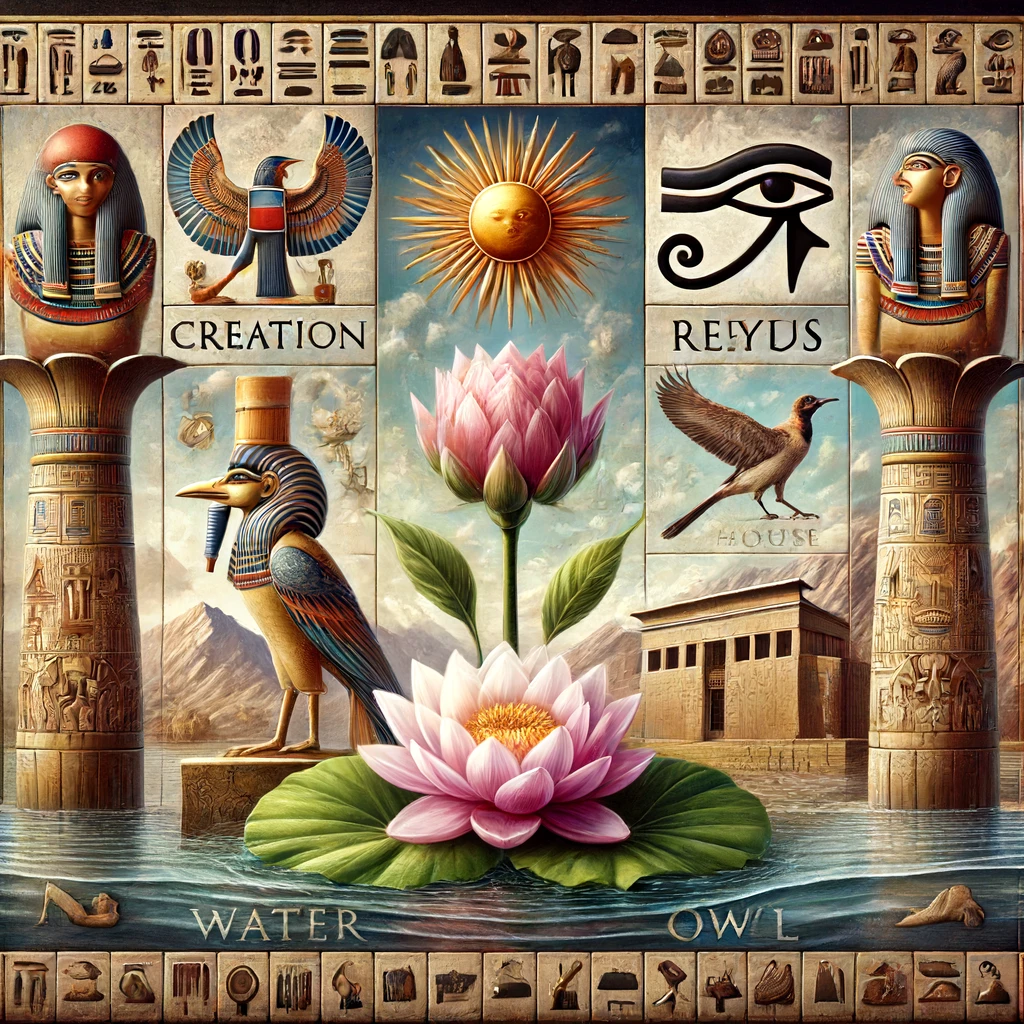
Common Hieroglyphic Symbols
29. Sistrum (Musical Instrument):
The sistrum, associated with the goddess Hathor, symbolizes joy and was used in religious ceremonies to invoke the divine.
30. Tyet (Knot of Isis):
The Tyet, also known as the Knot of Isis, is a symbol of protection and welfare, resembling an ankh but with arms that hang down and curve outward.
31. Kheper (Scarab Beetle):
The Kheper beetle symbolizes creation, rebirth, and the eternal cycle of life, often depicted pushing the sun across the sky.
32. Sekhem (Power):
The Sekhem scepter represents power and might, used in religious and ceremonial contexts to signify authority and strength.
33. Menat (Goddess Hathor):
The Menat is an amulet associated with the goddess Hathor, symbolizing fertility, life, and abundance, often worn by priests and priestesses.
34. Deshret (Red Crown of Lower Egypt):
The Deshret is the red crown symbolizing the rule over Lower Egypt, often depicted on the heads of deities and pharaohs in art.
35. Hedjet (White Crown of Upper Egypt):
The Hedjet is the white crown symbolizing the rule over Upper Egypt, commonly seen in depictions of pharaohs and gods.
36. Pschent (Double Crown):
The Pschent is the double crown combining the Deshret and Hedjet, symbolizing the unification of Upper and Lower Egypt under one ruler.
37. Flail (Symbol of Kingship):
The flail is a symbol of kingship and authority, often depicted with the crook, representing the pharaoh’s role as the provider and protector.
38. Crook (Symbol of Kingship):
The crook is a symbol of kingship and guardianship, representing the pharaoh’s role as a shepherd guiding and protecting his people.
39. Atef (Crown of Osiris):
The Atef crown, associated with Osiris, is a white crown adorned with ostrich feathers, symbolizing justice and truth.
40. Nemmes (Pharaonic Headdress):
The Nemmes is a striped headdress worn by pharaohs, symbolizing their divine status and authority over Egypt.
41. Khopesh (Sickle Sword):
The Khopesh is a curved sword used in ancient Egyptian warfare, symbolizing military power and the pharaoh’s ability to protect and conquer.
42. Sphinx (Guardian):
The sphinx is a mythical creature with the body of a lion and the head of a human, symbolizing strength, wisdom, and protection, often guarding temple entrances.
43. Obelisk (Sun Ray):
The obelisk is a tall, four-sided pillar that tapers to a point, representing a ray of the sun. It was often erected in pairs at the entrances of temples.
44. Ka (Spirit):
The Ka represents the spiritual essence or life force of a person, believed to continue to exist after death and needed sustenance from offerings.
45. Ba (Soul):
The Ba is the soul of a person, often depicted as a bird with a human head, representing individuality and the ability to travel between the earthly and divine realms.
46. Akhet (Horizon):
The Akhet symbol represents the horizon where the sun rises and sets, signifying the cycle of life and the eternal journey of the sun.
47. Sekhem Scepter (Symbol of Power):
The Sekhem scepter is a symbol of power and authority, often held by gods and pharaohs to denote their strength and dominion.
48. Was Staff (Power and Dominion):
The Was staff, often depicted with a forked base and an animal head, symbolizes power and dominion, carried by deities and pharaohs to show their control.
49. Serekh (Royal Insignia):
The Serekh is an early form of the royal insignia, depicting the pharaoh’s name within a stylized palace facade, signifying the king’s authority and protection.
50. Shen (Eternity):
The Shen ring symbolizes eternity and protection, often depicted encircling names and other important symbols to denote eternal protection.
Funerary and Afterlife Symbols
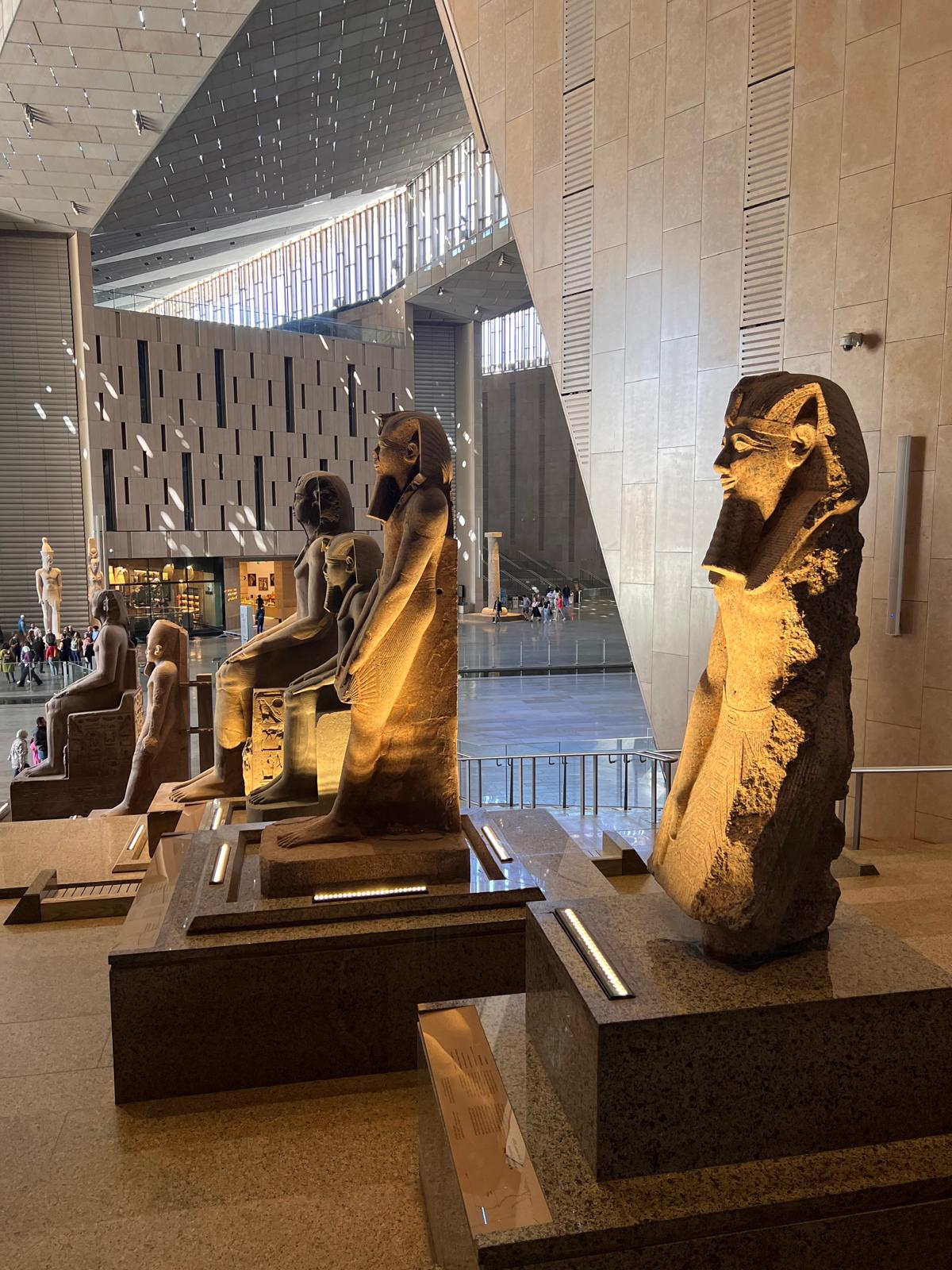
51. Ostrich Feather (Ma’at):
The ostrich feather represents Ma’at, the goddess of truth and justice, used in the weighing of the heart ceremony to judge the deceased’s soul.
52. Mummy (Preservation of the Dead):
The mummy represents the preservation of the body for the afterlife, symbolizing the belief in resurrection and eternal life.
53. Sistrum (Hathor’s Instrument):
The sistrum is a musical instrument associated with Hathor, used in religious ceremonies to invoke joy and the presence of the goddess.
54. Menat Necklace (Hathor’s Symbol):
The Menat necklace, often worn by priests and priestesses of Hathor, symbolizes fertility, life, and abundance.
55. Winged Sun Disk (Protection):
The winged sun disk symbolizes protection and divine power, often placed above temple entrances to ward off evil.
56. Cobra (Royal Protection):
The cobra, or Uraeus, represents royal protection and sovereignty, commonly worn on the pharaoh’s crown to signify divine authority.

57. Scarab Amulet (Transformation):
The scarab amulet symbolizes transformation and rebirth, used in jewelry and placed in tombs to ensure safe passage to the afterlife.
58. Djed Pillar (Stability):
The Djed pillar symbolizes stability and endurance, often included in tomb decorations and rituals to provide strength to the deceased.
59. Eye of Ra (Protection):
The Eye of Ra is a symbol of protection and power, representing the destructive and protective aspects of the sun god Ra.
60. Ib (Heart):
The Ib, or heart, is considered the seat of emotion, thought, and intention, central to the judgment of the soul in the afterlife.
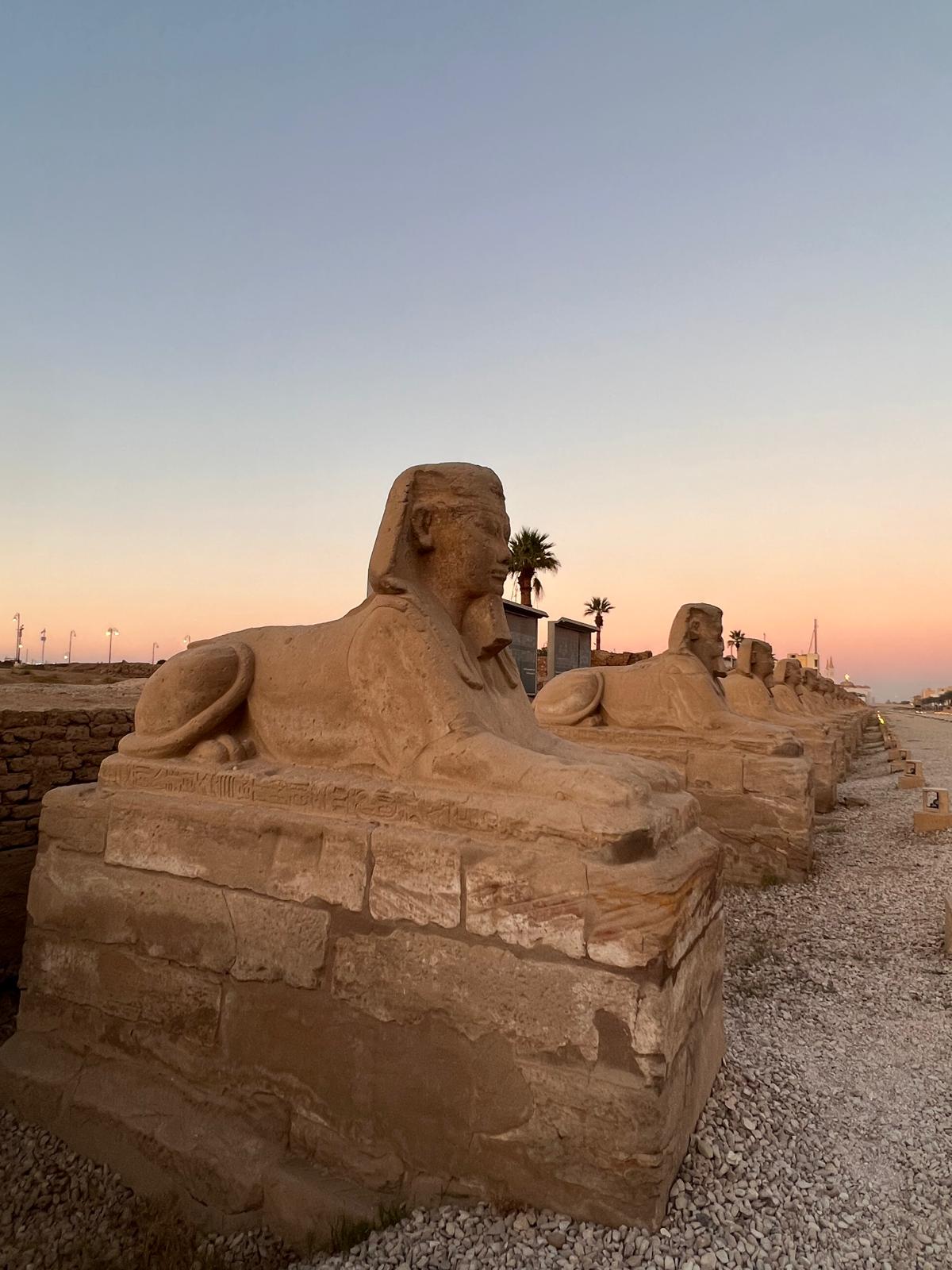
61. Heqa Scepter (Pharaonic Authority):
The Heqa scepter represents the authority and leadership of the pharaoh, often depicted in the ruler’s hands.
62. Ushabti (Servant Figurine):
Ushabti figurines were placed in tombs to serve the deceased in the afterlife, ensuring they had assistance with any labor required.
63. Sphinx (Wisdom and Strength):
The sphinx symbolizes wisdom and strength, often depicted as a lion with a human head, guarding sacred sites.
Cultural and Social Symbols
64. Bastet (Protection):
Bastet, depicted as a lioness or domestic cat, symbolizes protection, home, and fertility, revered as a guardian against evil spirits.
65. Hathor (Love and Joy):
Hathor, the goddess of love and joy, is often depicted with cow horns or as a cow, symbolizing nurturing and happiness.
66. Sekhmet (Warrior Goddess):
Sekhmet, depicted as a lioness, is the goddess of war and healing, representing fierce protection and power.
67. Neith (Weaving and Hunting):
Neith, the goddess of weaving and hunting, is depicted with a bow and arrows, symbolizing creation and the hunt.
68. Thoth (Wisdom and Writing):
Thoth, the god of wisdom and writing, is depicted as an ibis or a baboon, symbolizing knowledge and the recording of time.
69. Khnum (Creation):
Khnum, depicted as a ram, is the god of creation and the potter who fashioned humans from clay, symbolizing the creative force.
70. Sobek (Crocodile):
Sobek, the crocodile god, symbolizes strength and protection, revered for his ability to safeguard against dangers.
71. Horus (Sky and Kingship):
Horus, often depicted as a falcon, is the god of the sky and kingship, symbolizing divine kingship and protection.
72. Ptah (Craftsmanship):
Ptah, the god of craftsmen and architects, is depicted as a mummified man, symbolizing creation and craftsmanship.
73. Nut (Sky Goddess):
Nut, the goddess of the sky, is depicted arching over the earth, symbolizing the heavens and the protective canopy over the world.
74. Geb (Earth God):
Geb, the god of the earth, is often depicted lying beneath Nut, symbolizing the earth and its fertility.
75. Taweret (Childbirth):
Taweret, depicted as a hippopotamus, is the goddess of childbirth and fertility, symbolizing protection during pregnancy and childbirth.
76. Hapi (Nile God):
Hapi, the god of the Nile, symbolizes fertility and abundance, depicted with a potbelly representing the nourishing floods of the Nile.
77. Seshat (Writing and Wisdom):
Seshat, the goddess of writing and wisdom, is depicted with a seven-pointed star above her head, symbolizing knowledge and the recording of history.
78. Ankhet (Nourishment):
Ankhet, depicted with a water jar, is the goddess of nourishment and the life-giving waters of the Nile.
79. Tefnut (Moisture):
Tefnut, the goddess of moisture, is depicted as a lioness or a woman with a lioness head, symbolizing the vital moisture that sustains life.
80. Shu (Air and Light):
Shu, the god of air and light, is depicted holding up the sky, symbolizing the breath of life and the separation of earth and sky.
81. Atum (Creation):
Atum, the creator god, is depicted as a man wearing the double crown, symbolizing the creation of the world from chaos.
82. Khonsu (Moon):
Khonsu, the god of the moon, is depicted as a young man with a sidelock of youth, symbolizing time and the passage of the months.
83. Wadjet (Cobra):
Wadjet, the cobra goddess, is depicted as a rearing cobra, symbolizing protection and royal authority.
84. Nekhbet (Vulture):
Nekhbet, the vulture goddess, is depicted with outstretched wings, symbolizing protection and the Upper Egyptian kingdom.
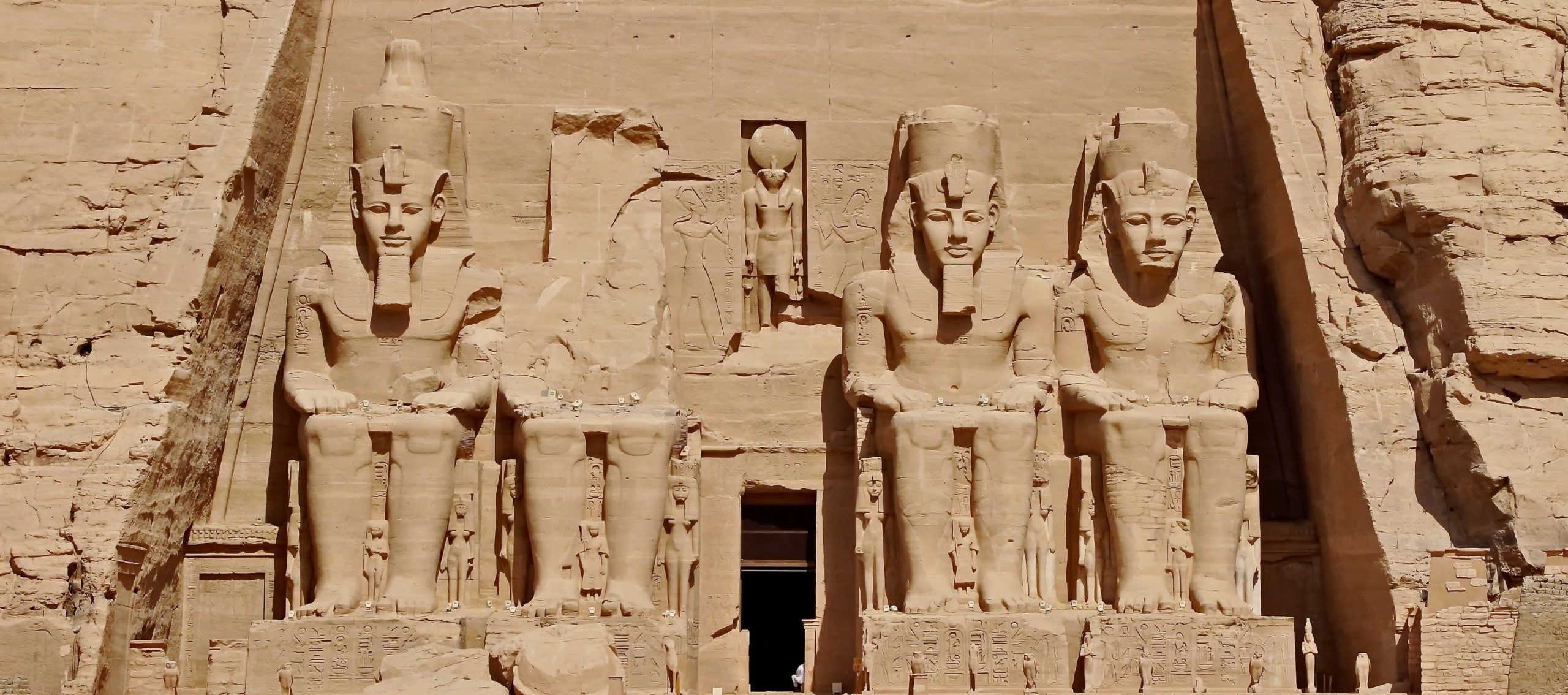
85. Mut (Mother Goddess):
Mut, the mother goddess, is depicted wearing a vulture headdress, symbolizing motherhood and the nurturing aspect of the divine.
86. Bes (Protection):
Bes, depicted as a dwarf with a lion-like face, is the god of home, childbirth, and protection, symbolizing joy and warding off evil spirits.
87. Serqet (Scorpion):
Serqet, the scorpion goddess, is depicted with a scorpion on her head, symbolizing protection against venomous creatures and healing.
88. Heket (Frog):
Heket, the frog goddess, symbolizes fertility and childbirth, with frogs being associated with the life-giving waters of the Nile.
89. Imhotep (Healing and Wisdom):
Imhotep, a deified mortal, is the god of healing and wisdom, symbolizing the power of knowledge and medical practice.
90. Nephthys (Protection of the Dead):
Nephthys, the goddess of protection for the dead, is depicted with a house and basket symbol on her head, symbolizing mourning and the safeguarding of the deceased.
91. Renenutet (Harvest):
Renenutet, the goddess of the harvest, is depicted as a cobra or a woman with a cobra head, symbolizing fertility and the bounty of the fields.
92. Maahes (Lion):
Maahes, the lion god, symbolizes war and protection, depicted as a lion or a man with a lion’s head.
93. Sopdu (Warrior God):
Sopdu, the warrior god, is depicted with falcon features, symbolizing protection, especially in the eastern desert.
94. Qebehsenuef (Canopic Jar):
Qebehsenuef, one of the four sons of Horus, protected the intestines of the deceased, depicted as a falcon.
95. Duamutef (Canopic Jar):
Duamutef, another son of Horus, protected the stomach, depicted as a jackal.
96. Hapy (Canopic Jar):
Hapy, also a son of Horus, protected the lungs, depicted as a baboon.
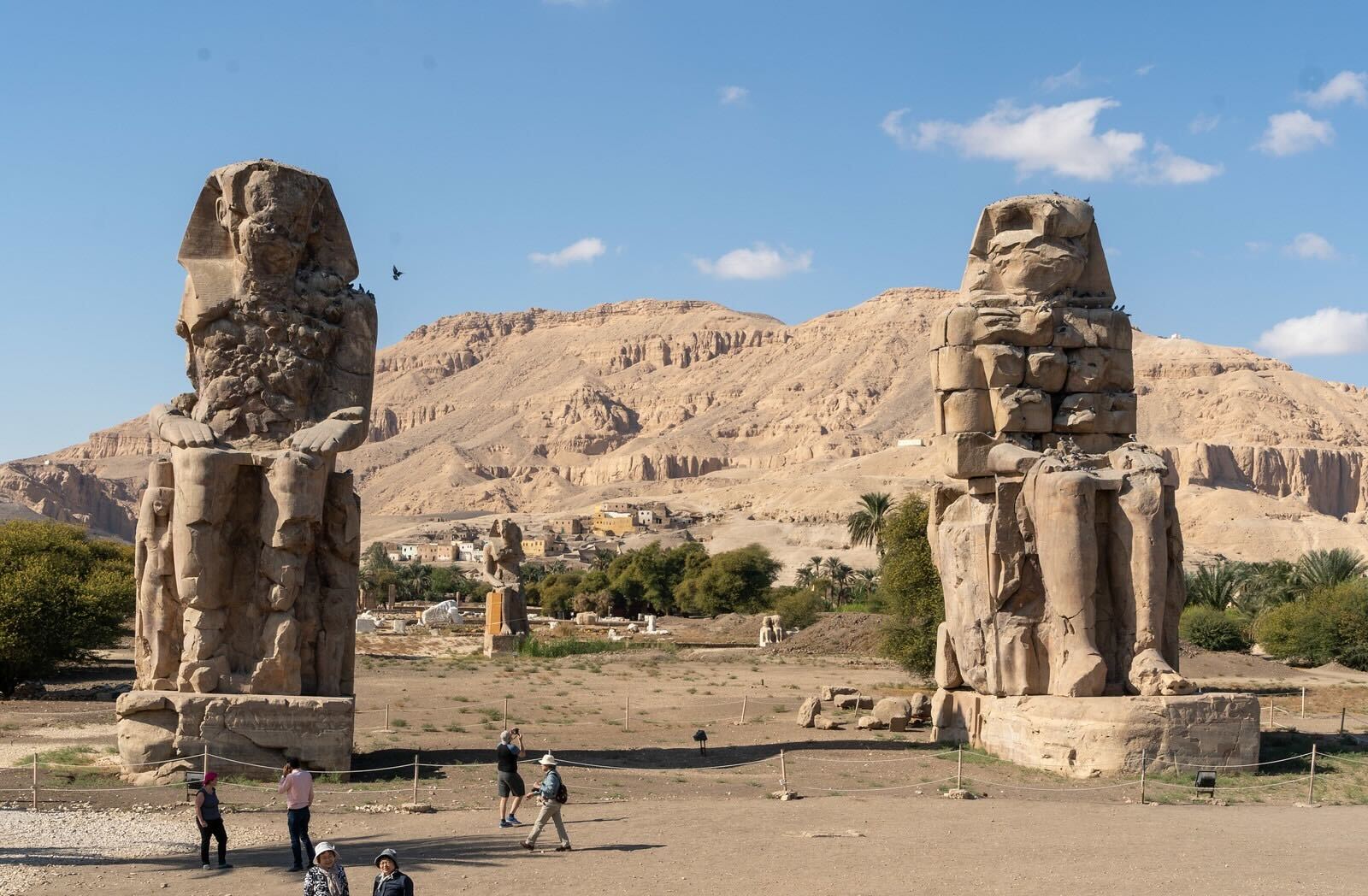
97. Imsety (Canopic Jar):
Imsety, the fourth son of Horus, protected the liver, depicted as a human.
98. Nefertum (Lotus):
Nefertum, the god of the lotus flower, symbolizes beauty and rebirth, often depicted emerging from a lotus.
99. Ptah-Sokar-Osiris (Afterlife):
Ptah-Sokar-Osiris is a composite deity symbolizing creation, stability, and resurrection, embodying the eternal cycle of life, death, and rebirth.
100. Ankhet (Goddess of the Nile):
Ankhet, the goddess of the Nile, symbolizes the nurturing and life-giving properties of the river, depicted carrying a scepter and ankh.
Conclusion:
Ancient Egyptian symbols are rich in meaning and deeply woven into the fabric of their culture. From the sacred symbols of gods and goddesses to the practical symbols used in daily life, each carries its own story and significance. These symbols provide us with a deeper understanding of the beliefs, values, and practices of one of history’s most fascinating civilizations.

